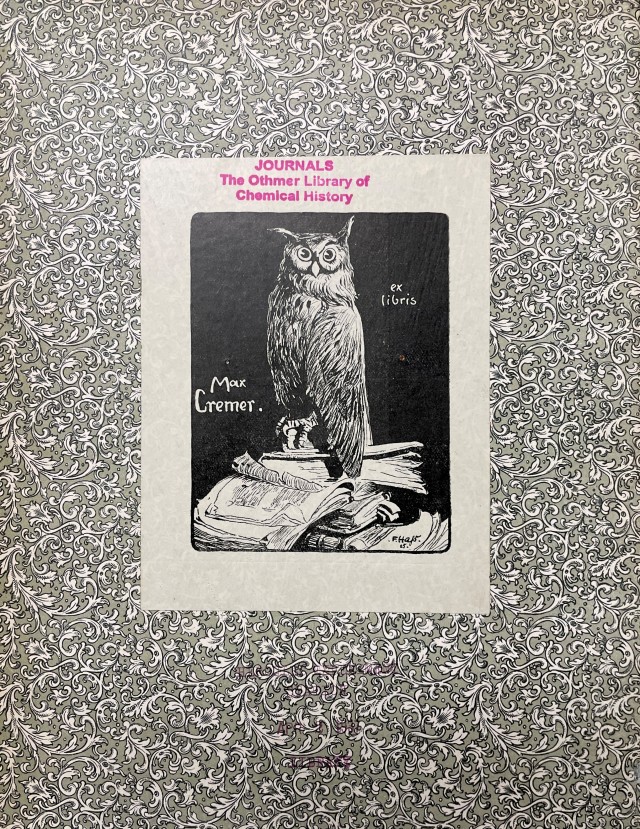#othmeralia

It’s Marbled Monday! Check out this marbling on our copy of Dissertatio physico-chemica (1784).


May 12th is International Nurses Day!
We have a few nursing materials in our collections such as Chemistry for Nurses (1914), pictured above, and Applied Chemistry for Nurses (1926).


May 11th is Twilight Zone Day!
It’s a weird, spooky, surreal day to celebrate the weird, spooky, and surreal!
Shown here is our copy of Hiding in the mirror (2005) which features a the opening narration from The Twilight Zone.


Uh-oh! Someone must have moved this page when running it through the printing press. It’s askew! This is kind of common in older books but still a fun surprise when I come across it!



Delivery!
Typically when we receive a new book in the mail it is boxed up nice and snug. Occasionally we get… well.. this. This book came wrapped in a little bit of cardboard which appears to be from a fire starter. Oh! And this book was shipped to us in Philadelphia, PA, from the United Kingdom!
What is the weirdest way you’ve received a book in the mail?



This book is not only about Nylon, it is also bound in Nylon covered boards with illustrations of nylon’s creation and uses. It was produced by du Pont in 1941 and discusses the history of Nylon development, the chemistry, production, and versatility of commercial uses.

Protolume chimico e cheggiante di condupplicati paraphrasi (1682) by Giovanni Francesco Aggravi.
This book is part of our Neville Collection which was purchased from Roy G. Neville. This is a first edition Venetian copy, 12mo. 6 leaves, and woodcut printer’s ornament on the title page. It is bound in contemporary vellum with old ink lettering on spine.
Nothing seems to be known of the author, Giovanni Francesco Aggravi (if you know information that might help, let us know! He’s most likely from the 17th century). The first half of this book covers chemical apparatus, operations, and process, with the second half focusing on an alphabetical list of preparations of chemicals, mainly for pharmaceutical uses.

It’s gonna be May
Peep that cute little May flower (that the April showers brought) growing out of the M.
Letter M comes from The true prophecies : or, Prognostications of Michael Nostradamus

April is National Welding Month
Shown here is a general view of acetylene welding at the U.S. Department of Agriculture’s Fixed Nitrogen Research Laboratory located in Washington, D.C. The man visible in the photograph is identified as J.J. Connor. This photograph is believed to have been taken in the electrical shop located at the Laboratory.

Thelarge red or the party coloured Crowfoote of Asia would be make for such a nice tattoo! This woodcut comes from Theatrum botanicum (1640).





A book in blue
This book is about the effect of colored light on plant physiology, specifically on whether sun rays on the blue scale improve crop growth and animal health. This concept (chromotherapy) is considered a pseudoscience, meaning the light in a blue color makes no difference on physiology. The concept was developed and the book written by Augustus James Pleasonton (1808-1894). The concept was expanded to human health and a “blue glass craze” was born and fizzled out within a few years.
Not only is the cover of this book blue but even blue ink was used to print the text. Besides red inks used sparingly on early-modern title pages, I’m not sure I’ve ever seen a lot of colored inks used in text based printing.

Honestly… this is me. Getting all dolled up to go read a book.
I feel you, Francis Bacon.
This frontispiece is found in Of the advancement and proficience of learning or the partitions of sciences(1640).

Title Page Tuesday
This is actually a really cool title page because it is one of ten books that is found inside Collectanea chymica(1684).

Ex Libris Max Cremer
This bookplate belonged to Max Cremer, a German physiologist (1865–1935) and inventor of the glass electrode. The bookplate is in our 1922 volume of Zeitschrift für Elektrochemie und angewandte physikalische Chemie.

The Golden Book of Chemistry Experiments: how to set up a home laboratory– over 200 simple experiments!
What could possibly go wrong!? Make sure you grab your safety goggles, gloves, and test tubes before conducting any experiments.

